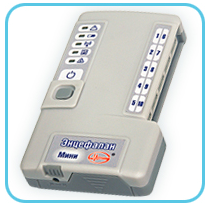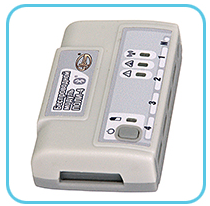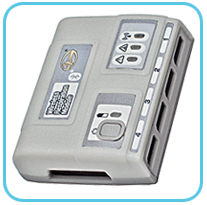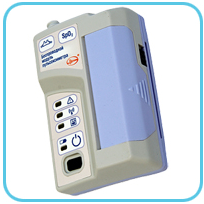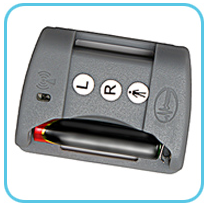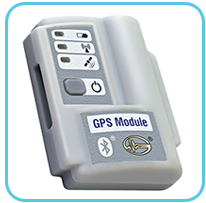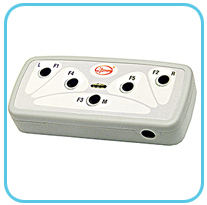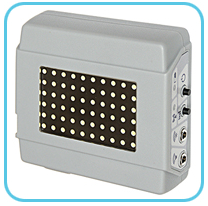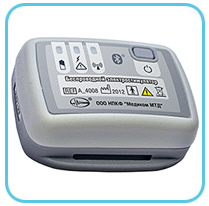Electroencephalograph-recorder
"Encephalan-EEGR-19/26". Main modification
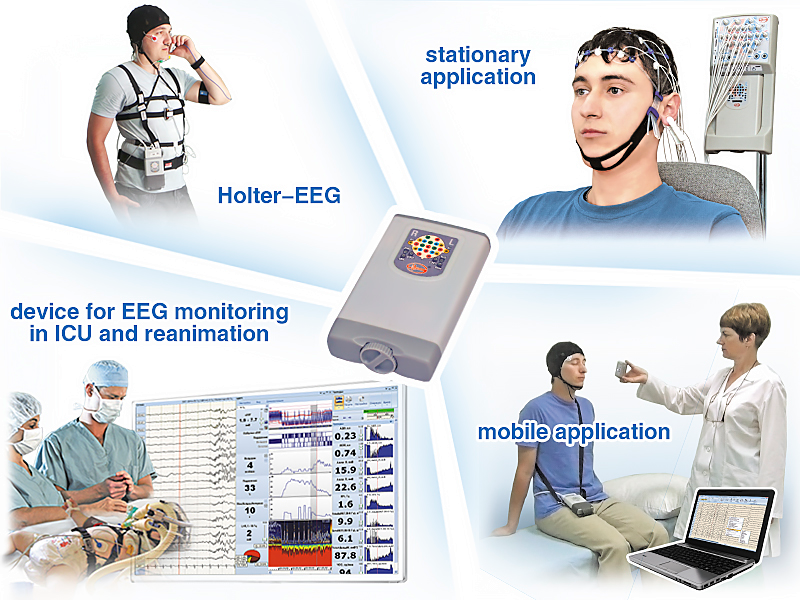
Electroencephalograph-recorder "Encephalan-EEGR-19/26" is the best universal tool for most tasks associated with control and diagnostics of the brain state at different neurophysiological studies and related fields.
- EEG studies can be carried out in attended or unattended mode. Connector EEG-20 provides switching between these modes (encephalograph transformation).
- EEG-videomonitoring with an accurate synchronization of the EEG data and video record provides the "gold standard" of epileptological studies.
- Holter-EEG is a 24-hour EEG monitoring at any patients location: in a hospital ward or at patient's home.
- Polysomnographic studies meet the requirements of international standards. The creation of sleep laboratories.
- Continuous multichannel neuromonitoring in the intensive care units and emergency room.
- Neurofeedback with a detailed EEG analysis and control, as well as biofeedback training by various physiological parameters.
- Multichannel polygraphic registration of parameters (neuromodular systems with synchronous record of up to 50 data channels) in sports medicine and scientific research.
Main technical characteristics of autonomous patient transceiver-recorder ABP-26
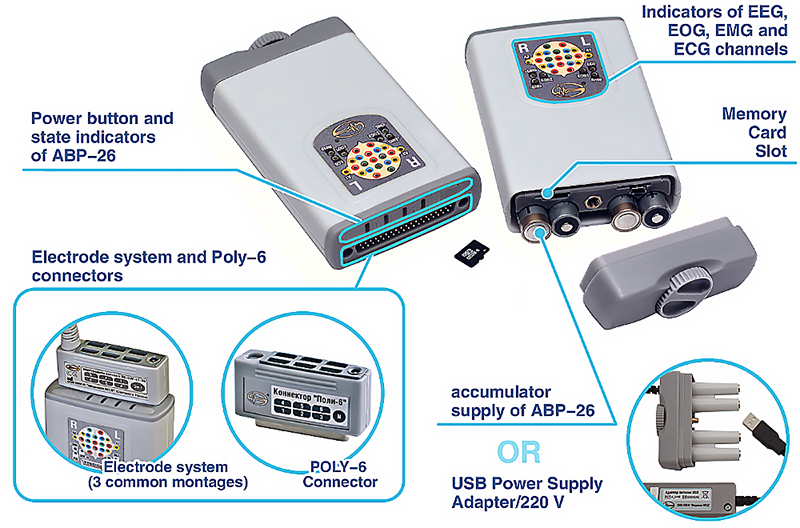
|
Number of channels |
26: 20 EEG, 1 ECG, 2 EOG, 1 EMG, 1 RR
1 body position channel (embedded 3-coordinated accelerometer) |
| Measurement and record of electrode impedance and electrode potential | Synchronously with EEG |
| DC-potential analysis (very low frequency activity) | Synchronously with EEG(optional Software "Encephalan- VLFA" is required) |
| Data record |
|
| ADC resolution |
24 bit |
| Input dynamic range | 0,005-8 mV |
| Noise, µV | 0.23 µV |
| Notch filter suppression ratio | ≥60 dB |
| Sensitivity: | 0,1….200 µV/mm |
| Common-mode rejection ratio (CMRR): |
|
| Input Impedance | ≥200 MΩ |
|
Electrode Impedance indication range |
0 - 50 kΩ |
| Signal filtering | Customizable low and high pass filter |
| LED Indication on ABP-26 enclosure | Service indicators:
|
| Power supply: |
|
| Interface of PC and additional modules network connection | Bluetooth |
| The maximum number of additional wireless recording devices, working with the basic device ABP-10 |
Up to 6 (depending on a montage used and type of device) |
| Defibrillator proof | Is provided when using a special adapter in combination with EEG electrodes with touchproof connector (cup, bridge, disposable) |
| Variants of attachment |
|
| Weight of ABP-26 | 400 g (without accumalators) |
| Size | 143×85×33 mm (W×H×T) |
Polysomnographs of professional and expert level
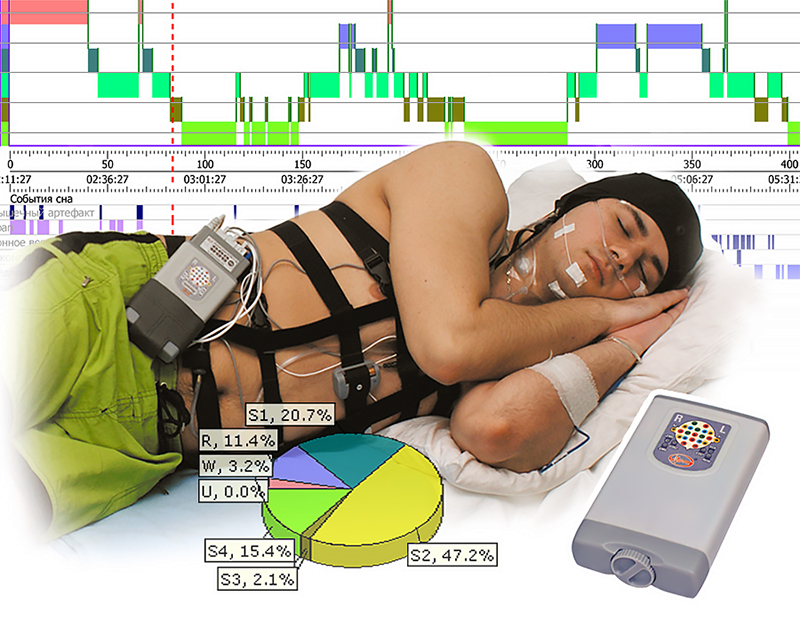
The main modification of electroencephalograph-recorder "Encephalan-EEGR-19/26" in combination with "maximum" suite of software "Encephalan-PSG" and necessary sensors forms polysomnograph with telemetric and autonomous (Holter-type studies) record for diagnostics of sleep disorder (insomnia, hypersomnia, parasomnia, narcolepsy), breathing disorders (sleep apnea syndrome, alveolar hypoventilation, snoring) and heart rate disorders, ischemic heart disease, neurological and psychosomatic disorders (epilepsy, restless legs syndrome).
"Professional" suite
- Autonomous patient transceiver-recorder ABP-26 – EEG (12 derivations), EOG (2), EMG (1), ECG (1), abdominal and thoracic respiratory effort, respiratory airflow, snore, 2 EMG derivations for detection of restless legs syndrome, body position sensor, 1 (built-in accelerometric sensor);
- Wireless pulse oximeter module (SpO2);
- Additional POLY-4 module: EMG (2 derivations) and movement activity sensors-2 (provide registration);
- or additional wireless module PG-ECG: ECG-3; impedance-based pneumogram -1.
"Expert" suite
- Patient transceiver-recorder ABP-26 – EEG (20 derivations), EOG (2), EMG (1), ECG (1), body position sensor-1 (built-in accelerometric sensor);
- Wireless pulse oximeter module (SpO2);
- Additional POLY-4 module (1-2): abdominal and thoracic respiratory effort, respiratory airflow, snore, 2 EMG derivations, wired movement activity sensors – 2.
- or additional autonomous patient transceiver-recorder ABP-10 (POLY-10 mode) provides a connection of up to 10 additional polygraphic electrodes in any combination.
"Encephalan-PSG" software
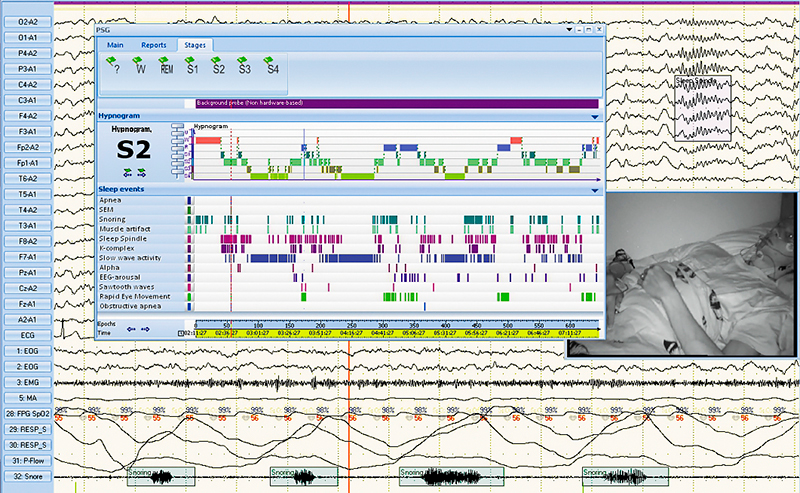 "Maximum" software suit provides wide range of functional capabilities taking into account recommendations of the AASM and the CSM.
"Maximum" software suit provides wide range of functional capabilities taking into account recommendations of the AASM and the CSM.
Automatic search and differential diagnostics of central, obstructive and mixed sleep apnea on the basis of data from thoracal and abdominal respiratory effort, respiratory airflow and SpO2 sensors;
Analysis of cardiovascular system disorders associated with apnea events (1 or 3 ECG channels);
Automatic search of oxygen desaturation events;
Automatic search of snore events;
Detection and analysis of patient body position;
Automatic search and differential diagnostics of central, obstructive and mixed sleep apnea.
Presentation of sleep events in one time scale with trends of respiratory rate, nominal respiratory amplitude, nominal respiratory minute volume, SpO2, heart rate, mean and maximal amplitude of snoring signal.
Reports with calculated indices of snoring, desaturation and respiratory disorders according to body position, with data on the change of oxygen saturation and heart rate as well as report form with data on body position in sleep.
Manual or automatic hypnogram building using quick search of required fragments and trends of calculated parameters.
Analysis of limbs movements for detection of restless legs syndrome.
Software provides analysis of sleep phases, automatic building and manual editing of hypnogramms, and also allocation of sleep events, formation of sleep statistic reports and reports of sleep stages distribution.
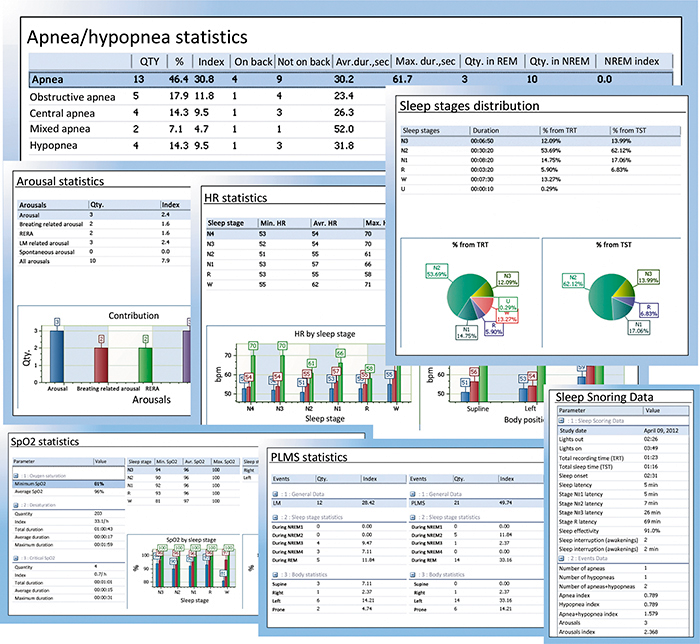 Marking of brain activity patterns for sleep stages determination (sleep spindles, K-complexes, saw-tooth waves), automatic calculation of sleep statistical indices (sleep scoring) and selected sleep events (indices, number and duration of episodes) are additionally provided.
Marking of brain activity patterns for sleep stages determination (sleep spindles, K-complexes, saw-tooth waves), automatic calculation of sleep statistical indices (sleep scoring) and selected sleep events (indices, number and duration of episodes) are additionally provided.
Reports, which contain data in tables and graphical form, are formed according to common international standards (AASM). Report can contain fragments of raw signals, selected phenomena, video data and parameters trends.
Software "Encephalan-EEGR" is used for Full-valid EEG analysis.
Polysomnographs can be supplemented with autonomous, mobile or stationary kit for EEG-PSG videomonitoring.
Please contact us to receive full quotation, catalogues and price-list with your personal conditions.
Mail: This email address is being protected from spambots. You need JavaScript enabled to view it.
Skype: tenmed1
Monitoring in the emergency room and intensive care units
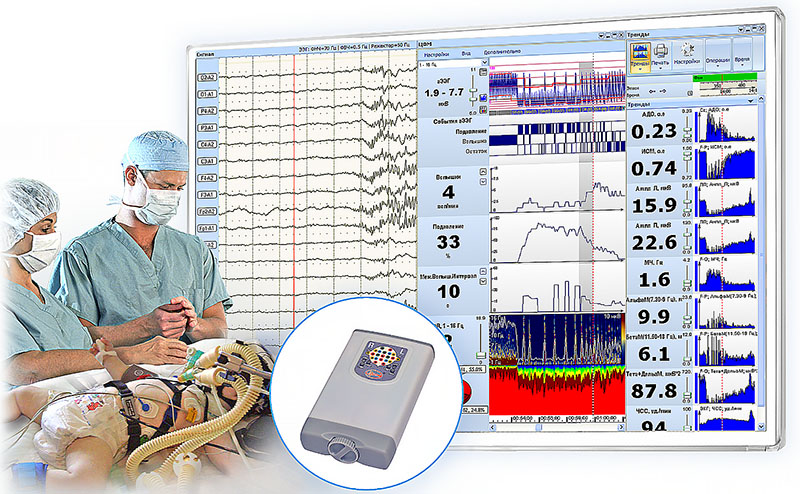 Portability of patient transceiver-recorder ABP-26, backup of all recorded data on the internal memory card and wireless data transmission to the computer provide high noise immunity from the effects of different equipment in the emergency room and intensive care units.
Portability of patient transceiver-recorder ABP-26, backup of all recorded data on the internal memory card and wireless data transmission to the computer provide high noise immunity from the effects of different equipment in the emergency room and intensive care units.
Biofeedback and neurofeedback equipment
Biofeedback training is efficiently used for:
- non-medicated reactivation of impaired functions at neurorehabilitation of patients with consequences of cerebral blood flow impairments (stroke), traumatic brain and cerebrospinal injuries;
- correction of psychophysiological state in athlets and people of stressful and responsible professions;
- training skills of state management for optimal functioning;
- overcoming phobias and pathological addictions;
- adjuvant therapy for autonomic dysfunctions, cardiovascular diseases, motor disturbances and attention deficit hyperactivity disorder in children and teenagers;
- improvement of the adaptive capacity and stress resistance, and psychoemotional sphere optimization.
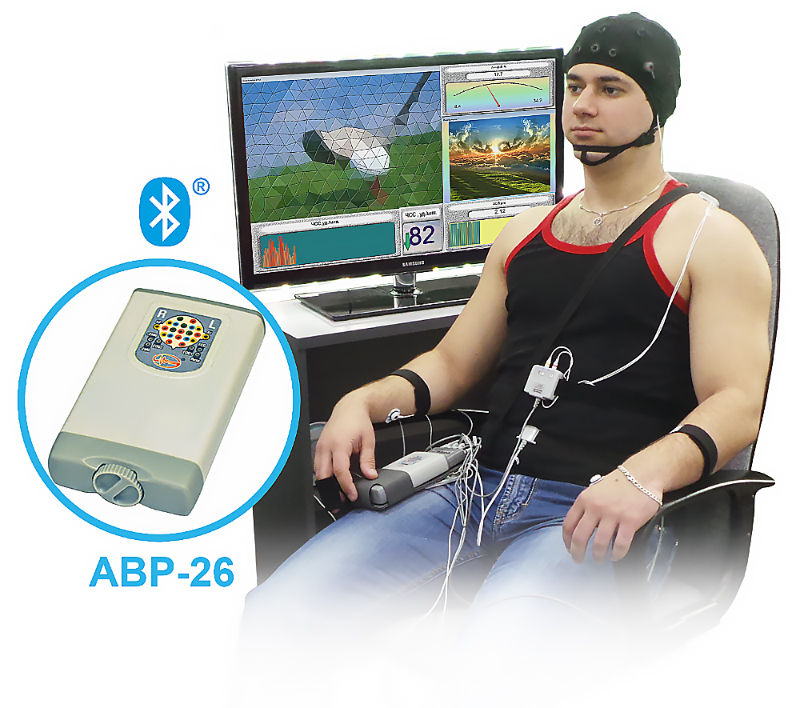 The main features of the electroencephalograph, main modification, are:
The main features of the electroencephalograph, main modification, are:
- 12 or 20 EEG derivations providing greater possibilities for biofeedback and neurofeedback procedures by EEG and DC-potentials using quantitative methods of analysis (qEEG, aEEG).
- professional neurophysiological support using software for electroencephalograpical studies and additional software.
Electroencephalograph-recorder "Encephalan-EEGR-19/26", main modification allows carrying out additional types of biofeedback training:
- Balance training while maintaining a vertical posture on a balance platform.
- Simultaneous operator performance training with tracing and logic task solving.
- Training of the stress resistance skills using somatosensory stimulator.
Multifunctional neuromodular diagnostic systems for scientific research and sports medicine
Depending on the availability of additional wireless devices, modules and sensors in the sales package, electroencephalograph-recorder provides multichannel multi-parameter record (over 50 parameters) in various combinations, such as:
|
|
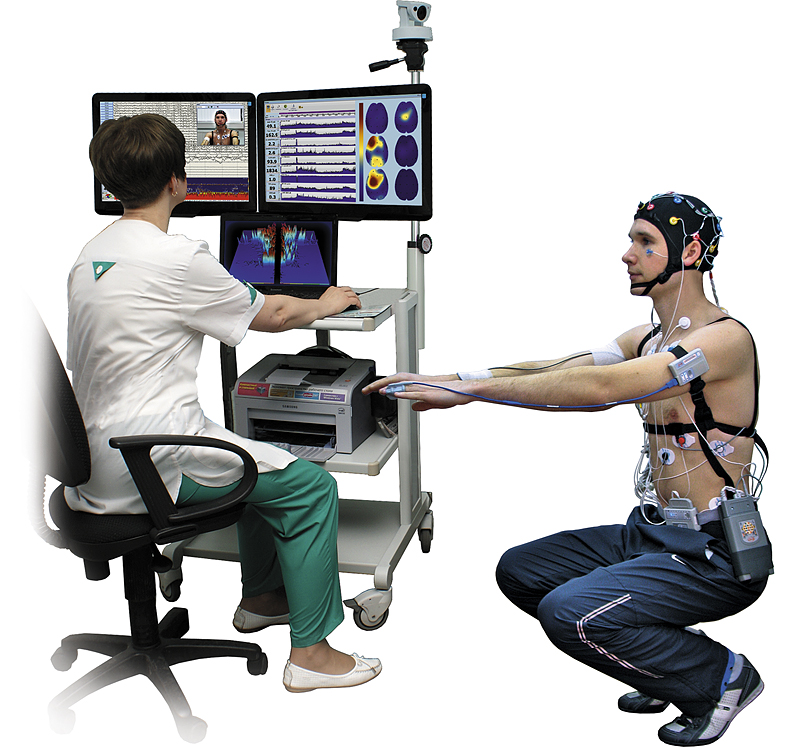
The main transceiver-recorder ABP-26 provides EEG record, obtaining data from wireless devices and sensors with saving information onto internal memory card during autonomous (Holter-type) working mode or provides data transition via wireless Bluetooth channel to the personal computer during study carrying out.
Please contact us to receive full quotation, catalogues and price-list with your personal conditions.
Mail: This email address is being protected from spambots. You need JavaScript enabled to view it.
Skype: tenmed1
Wireless modules, sensors and electrodes, applied with block ABP-26
Original concept of unification of hard- and software for electroencephalographs-recorders "Encephalan-EEGR-19/26" provides a unique opportunity of combination of autonomous patient transceiver-recorder ABP-26 with additional modules and sensors, which allows you to create unified multifunctional neuromodular diagnostic systems with synchronous recording of more than 50 different signals.
|
ABP-10 in the Poly-10 mode Record of signals by 10 polygraphic channels. |
Wireless universal Poly-4 module Record of signals by 4 polygraphic channels. |
|
Wireless Respiration Module Record of respiration parameters by 4 channels. |
Wireless pulse oximeter module Record of arterial blood oxygen saturation |
|
Wireless Movement Sensor Record of data on movement activity in three |
Wireless GPS-tracker For tracking the position and motion path |
|
Patient button unit for detecting Is used for cognitive EP studies (CNV, P300) |
Stimulator SFN/FO-04 (autonomous For functional tests on photostimulation during |
|
Wireless electrostimulator For somatosensory stimulation for patient's |
Optional software
- "HRV" Software for Heart Rate Variability Analysis provides evaluation of autonomic nervous system (ANS) state on the basis of HRV study.
- "Encephalan-EP" Software for EP-studies – provides long latency evoked potentials (EP) studies to stimuli of different modality (visual, auditory, somatosensory) with stimulators.
- "Encephalan-MPA" Software for multiparameter analysis of signals from polygraphical channels in combination with EEG signals (if additional wireless devices and sensors are purchased).
- "Encephalan-PSG" Software for Somnological studies (if additional wireless devices and sensors are purchased). Software provides analysis of sleep phases, automatic building and manual editing of hypnogramms, and also allocation of sleep events, formation of reports of sleep statistics, sleep stages distribution and respiratory disorders.
- "Encephalan-AVS" Software for EEG and EP studies with audiovisual stimulation. Software provides flexible creation and playback of scenarios of cognitive stimulation using graphic images, audio files and text information as stimuli.
- Analysis of Very Low Frequency Activity "Encephalan-VLFA". Software allows analyzing very slow EEG responses simultaneously with EEG recording by the same derivations.
- Three-dimensional localization of electrical activity sources "Encephalan-3D" displays a conditional source of electrical activity in the three planes of a brain cut in the form of a spatial cloud of dipoles, which allows us to localize the focus of epileptiform EEG activity or source EP components.
- Software for Functional Brain Asymmetry Analysis "Encephalan-FBA" provides visualization of cortico-cortical couplings maps by calculating the reciprocal functions (cross-correlation, cross-spectrum, the coherence function) for the diagnosis of inter- and intracortical dysfunctions, detection of the focuses of pathological activity, as well as for treatment monitoring.
- "Rehacor" Software for Functional Biocontrol with Biofeedback Training provides training and rehabilitation with biofeedback using various physiological parameters. It’s used for non-medicated reactivation of impaired functions, improving neural regulation, overcoming phobias and pathological addictions, optimization of psychophysiological state in athletes and people of stressful and responsible professions, as well as for overcoming attention deficit hyperactivity disorder in children and teenagers.
Please contact us to receive full quotation, catalogues and price-list with your personal conditions.
Mail: This email address is being protected from spambots. You need JavaScript enabled to view it.
Skype: tenmed1



